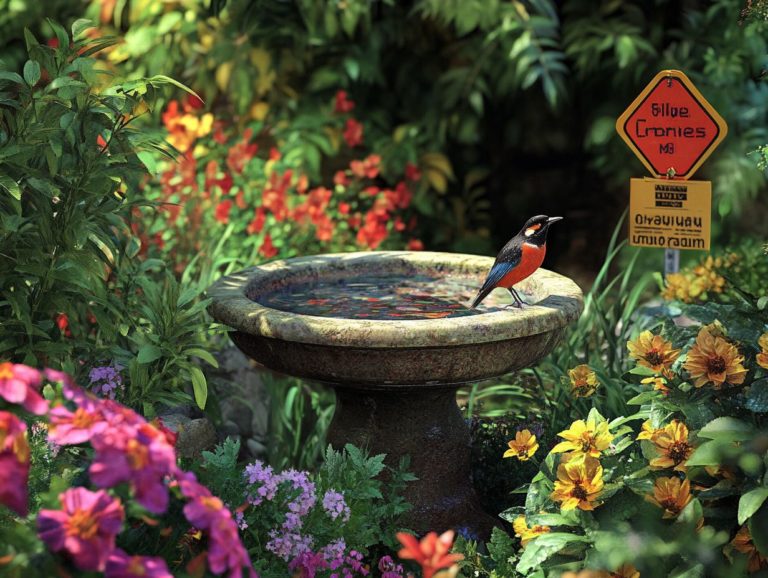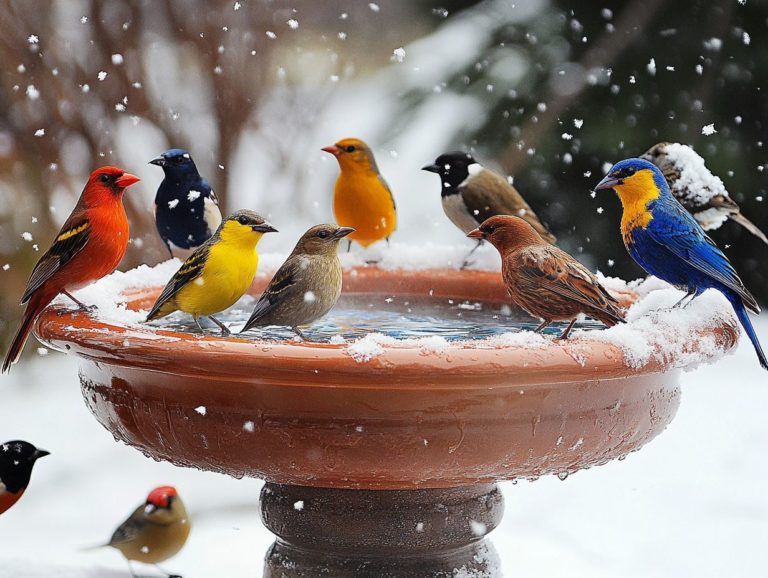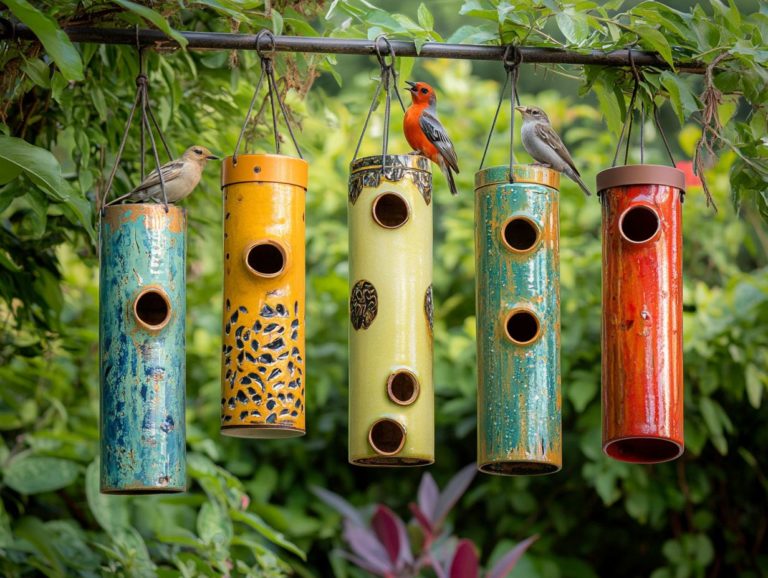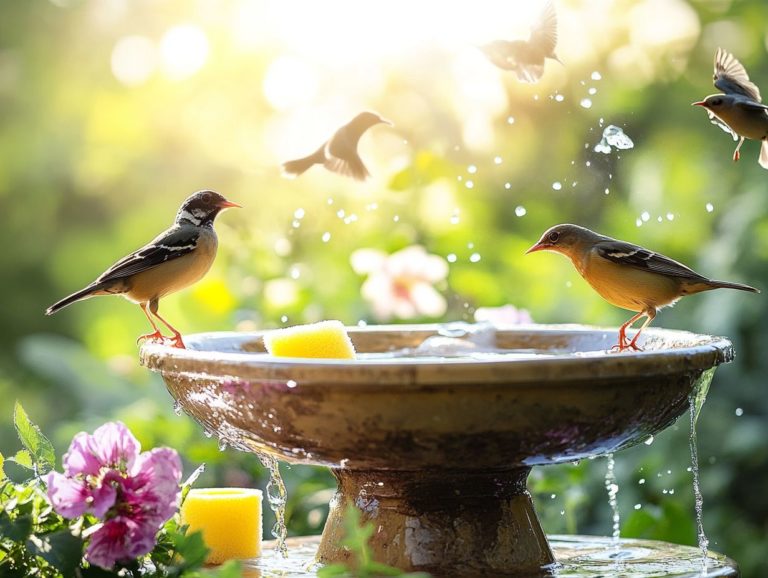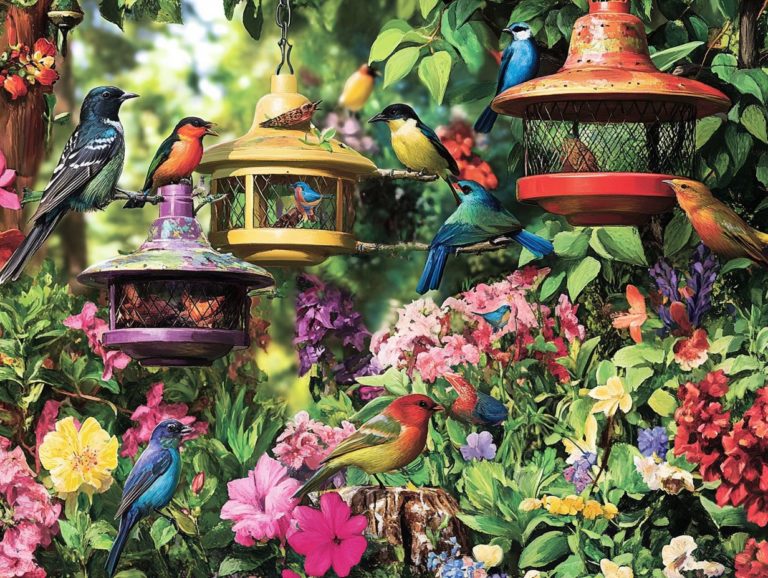How to Create a Bird-Friendly Backyard
Creating a bird-friendly backyard is a rewarding endeavor that enhances both the bird population and the environment.
By incorporating native plants, providing food sources, and ensuring safe shelter, you can transform your outdoor space into a sanctuary for local birds.
You will learn common hazards to avoid and gain insights for enjoying birdwatching in your backyard.
Engage with this guide and start making a positive impact on your surroundings today!
Contents
- Key Takeaways:
- Why Create a Bird-Friendly Backyard?
- Choosing Native Plants
- Providing Food Sources
- Creating Shelter and Nesting Spots
- Eliminating Hazards
- Enjoying Your Bird-Friendly Backyard: Tips for Success
- Frequently Asked Questions
- 1. What are the benefits of creating a bird-friendly backyard?
- 2. How can I make my backyard more inviting for birds?
- 3. What types of plants should I include in my bird-friendly backyard?
- 4. Are there any plants that should be avoided in a bird-friendly backyard?
- 5. How can I keep my backyard safe for birds?
- 6. What else can I do to create a bird-friendly backyard?
Key Takeaways:
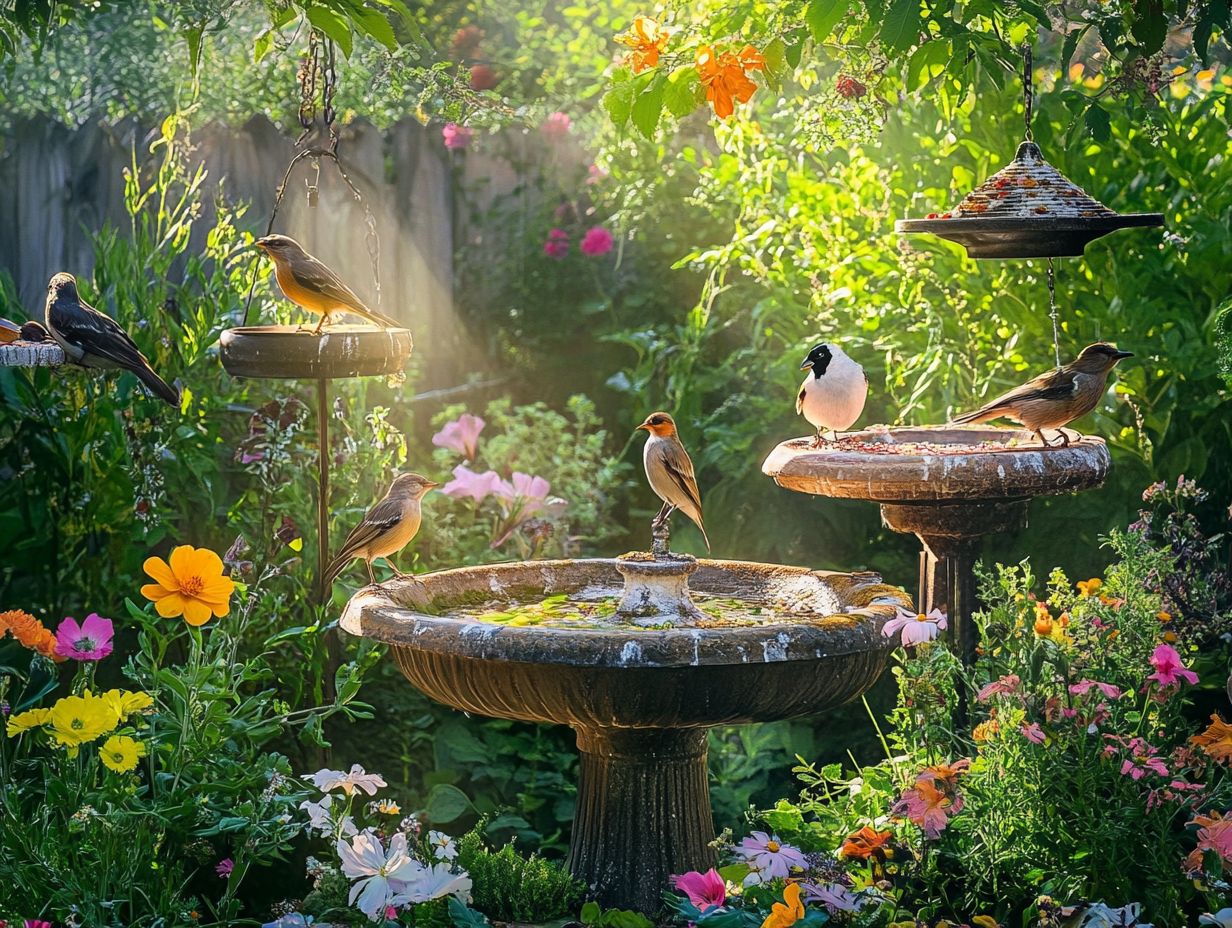
- 1. A bird-friendly backyard benefits birds and the environment. It also adds beauty and enjoyment to your outdoor space.
- 2. Choosing native plants is vital for attracting local birds and providing food.
- 3. In addition to traditional feeders, insect-friendly gardens attract a variety of bird species.
Why Create a Bird-Friendly Backyard?
Creating a bird-friendly backyard enriches the lives of birds by offering food and nesting sites while also improving the environment by promoting a variety of living things and a balanced environment.
A well-designed outdoor space can become a sanctuary where local bird species thrive, enhancing the overall health of the ecosystem.
Get involved in conservation efforts and discover a deeper connection with nature while helping to create healthier habitats for wildlife in your community.
By understanding the needs of birds and using effective strategies, you can cultivate an environment filled with melodious bird songs and vibrant life, while also addressing important issues like climate change and habitat loss.
Benefits for Birds and the Environment
Creating a bird-friendly environment brings many benefits, not just for our feathered friends but also for the ecosystem and human health.
By cultivating habitats that support various bird species, you can enhance local biodiversity, which is crucial for resilient ecosystems. These diverse bird populations help control pests and disperse seeds, fostering the growth of native plants.
Incorporating native species into these habitats strengthens their effectiveness and promotes overall ecological health.
As urban areas face habitat loss, your involvement becomes vital. By taking action, you create spaces that nurture birds and the intricate web of life around us.
Choosing Native Plants
Selecting native plants is essential for creating a bird-friendly backyard. These plants provide vital food sources and habitats that support local bird populations, ensuring a thriving ecosystem.
Bird-friendly plants can also attract butterflies and other beneficial insects, enriching your garden’s biodiversity.
Attracting Local Bird Species
Attracting local bird species starts with selecting the right native plants that serve as food sources and shelter. This thoughtful selection beautifies your backyard and promotes ecological balance.
Consider how native shrubs and trees yield fruits, seeds, and insects that many birds depend on for nourishment. A diverse array of flowering plants can provide nectar for hummingbirds, while densely branched shrubs create ideal nesting spots for smaller species.
By incorporating these native plants, you contribute to a flourishing ecosystem, fostering biodiversity that benefits avian life and essential pollinators. With a well-planned garden, you reclaim natural habitats and enhance the overall health of local environments.
Providing Food Sources
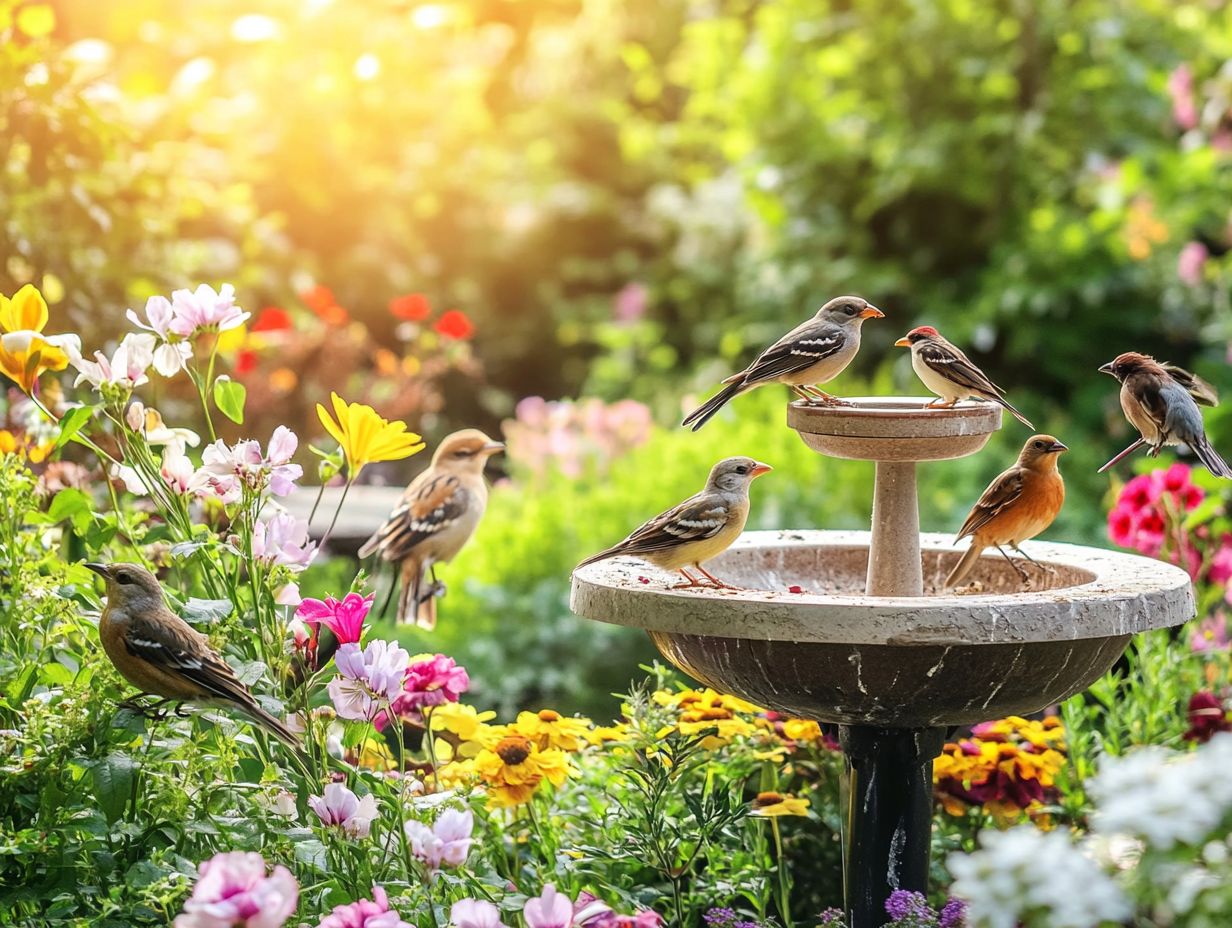
Offering a variety of food sources is key to attracting birds to your backyard. Set up bird feeders with assorted seeds and plant species that support local insect communities.
This approach attracts many birds and creates a lively ecosystem right outside your door. It also helps protect different species.
Seed and Nectar Feeders
Seed and nectar feeders draw a delightful variety of bird species. You ll enjoy visits from colorful goldfinches and robust blue jays.
Using mixed seed blends helps attract various species, ensuring every feathered guest finds something tasty. Check with local wildlife organizations for the best seeds for your area.
Regular maintenance of these feeders boosts their effectiveness. It also helps create a healthier ecosystem, nurturing a thriving community of birds.
Insect-Friendly Gardens
Creating insect-friendly gardens is essential for fostering a balanced ecosystem. These gardens provide vital food sources for birds by promoting robust insect populations, including caterpillars, which are crucial for many bird species.
By incorporating native species and utilizing organic compost, you can enhance your garden’s habitat while attracting a diverse array of beneficial insects. This strategy encourages the natural interactions that sustain these populations.
As insects thrive, they provide nourishment for birds, contributing significantly to the overall health of avian communities.
Embrace sustainable practices and transform your garden into a haven for insects and birds!
Creating Shelter and Nesting Spots
Creating sufficient shelter and nesting spots is essential for supporting local bird populations. By providing these safe havens, you ensure they have secure spaces to raise their young right in your backyard habitat.
Importance of Shelter for Birds
The importance of shelter for birds cannot be overstated. It s crucial for their survival and wellbeing, offering safe nesting sites and protection from predators.
This protective environment is essential not just for individual species but also for maintaining ecological balance across diverse habitats. When various bird species find refuge in well-designed shelters be it in urban gardens, rural landscapes, or natural reserves they actively contribute to the intricate web of life.
Birds take on vital roles as pollinators and seed dispersers, facilitating plant growth and ensuring healthy ecosystems.
Introducing shelters enhances biodiversity, attracting a multitude of species that enrich local flora and fauna while also helping to manage pest populations. Ultimately, providing adequate shelter fosters a flourishing environment that benefits both wildlife and the broader ecosystem.
DIY Nesting Boxes
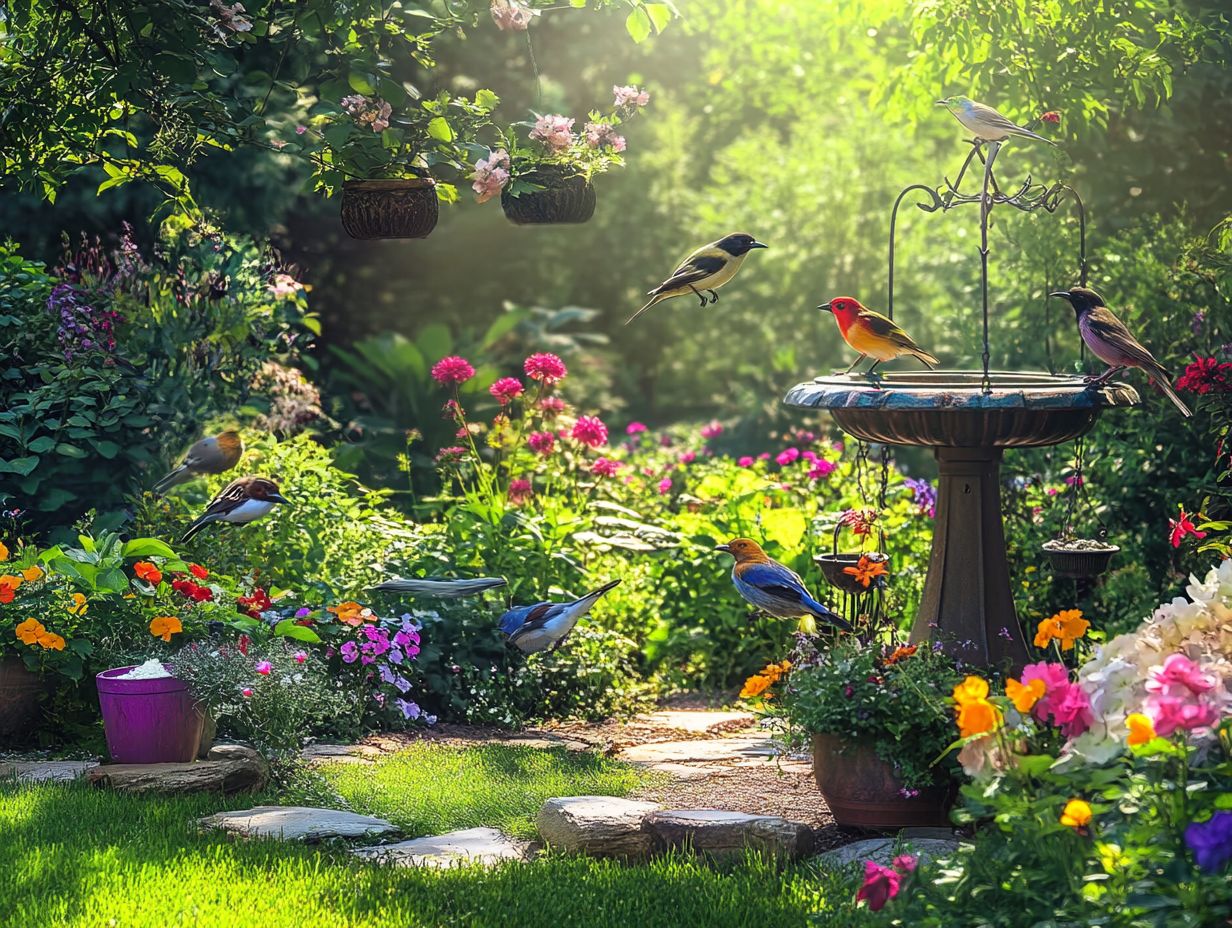
Building DIY nesting boxes is not only simple but also a highly effective way to create safe nesting sites for various bird species in your backyard habitat, making it easier to watch birds and promoting bird conservation efforts.
By taking a few mindful steps, you can craft structures that enhance local ecosystems while promoting bird conservation. Start by selecting suitable, untreated wood such as cedar or pine; these materials are durable and naturally resistant to decay. Design the boxes with proper airflow and holes for water to escape to ensure the interior remains comfortable and secure for your feathered friends.
When deciding on placement, choose locations that offer nearby cover while remaining sheltered from harsh weather. Partnering with local conservation groups gives you valuable insights and resources, enabling you to promote bird-friendly practices in your community.
Eliminating Hazards
Make your backyard a safe haven for birds. Eliminate hazards so they can thrive without the threat of dangers or stressors. By thoughtfully removing potential risks, you create a welcoming space where avian visitors can flourish in peace and safety.
Common Backyard Hazards for Birds
Common backyard hazards for birds include invasive species (plants or animals that aren t native and can harm local wildlife), chemical treatments used in lawn care, and the lurking presence of domestic pets that can pose real threats to bird migration and local biodiversity.
These risks endanger birds and disrupt ecosystems. Imagine invasive plants choking out native flora, which ultimately diminishes the food sources and nesting sites that local bird species rely on. Lawn chemicals, like pesticides and herbicides, can seep into the soil and waterways, wreaking havoc on both birds and their invertebrate prey. Meanwhile, your pets cats and dogs can turn into unexpected predators, contributing to declines in populations of smaller bird species.
Create a safe backyard habitat today! Use native plants, avoid harmful chemicals, and implement safeguards against pets to make a significant contribution to the conservation of your feathered neighbors.
Safe Pest Control Methods for a Healthy Backyard
Utilizing safe pest control methods is essential for maintaining environmental health and protecting bird habitats from harmful chemicals and invasive species that threaten native species.
By adopting organic pest control strategies, you can cultivate a more balanced ecosystem that safeguards the wellbeing of avian species and nurtures an environment where native plants can thrive and support pollinators.
Here are some effective methods:
- Introducing beneficial insects like ladybugs and lacewings,
- Using barrier methods like insect netting, and
- Embracing companion planting are vital practices for promoting a healthy ecosystem.
These strategies minimize harm to wildlife and contribute to a holistic approach to gardening that supports biodiversity.
Encouraging natural predators will also help reduce pest populations without resorting to intrusive measures, ensuring that both birds and beneficial insects have a safe habitat to flourish, further enhancing your backyard habitat.
Enjoying Your Bird-Friendly Backyard: Tips for Success
Transform your backyard into a welcoming space for birds. Enjoy birdwatching and connect with nature while supporting the local ecosystem and contributing positively to biodiversity conservation.
Tips for Bird-Watching and Maintenance
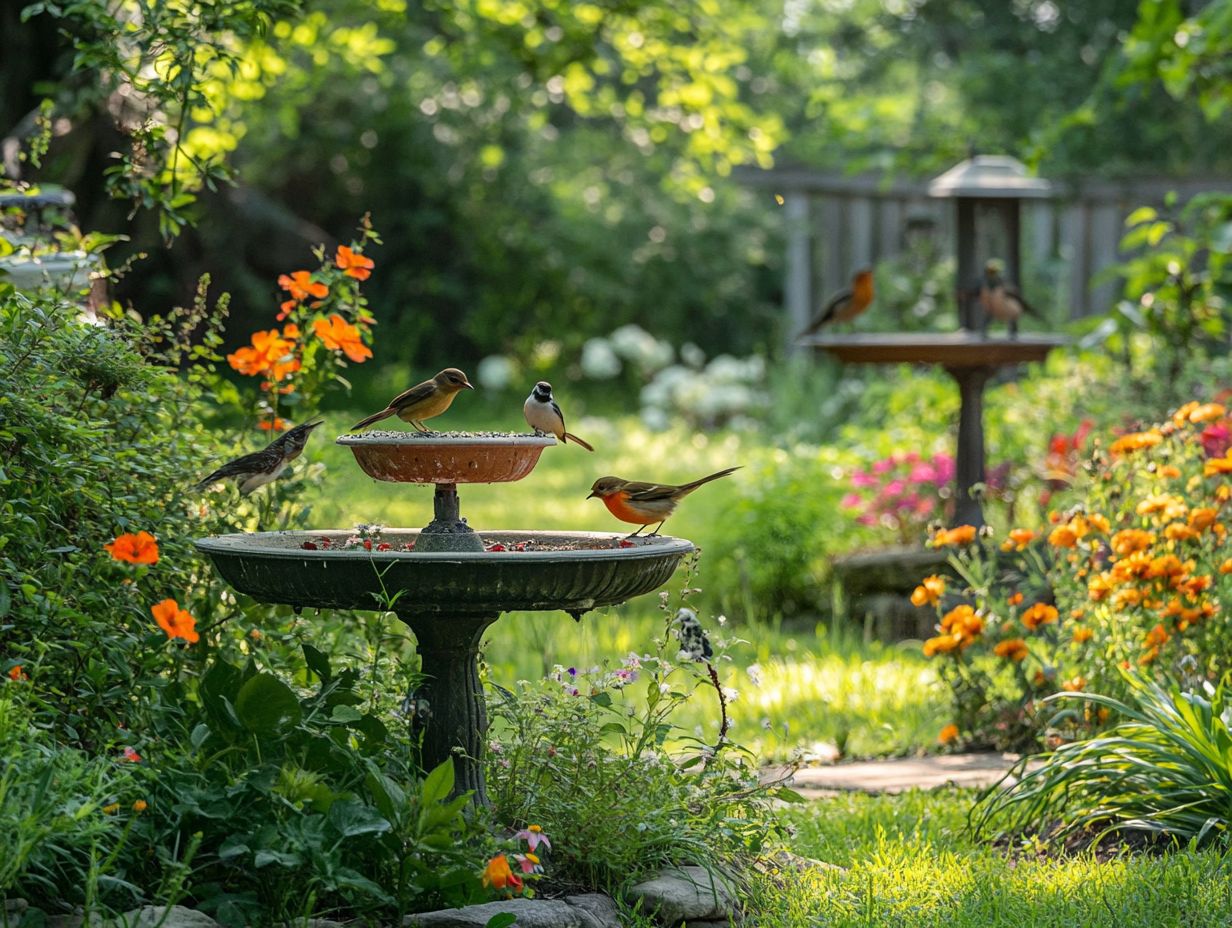
Birdwatching in your backyard can be an enchanting experience. By maintaining your outdoor space, you not only ensure ongoing enjoyment but also support local bird populations.
Transform your backyard into a bird haven! Attract a variety of species and connect with nature. Consider planting native trees and shrubs that provide food and shelter while promoting a variety of plants and animals.
Installing bird feeders filled with an assortment of seeds will entice different birds to visit, infusing your yard with a lively atmosphere. Engaging with local community groups dedicated to gardening that helps the environment can further enrich your backyard habitat, as they often share invaluable resources and insights on best practices for bird conservation.
Frequently Asked Questions
1. What are the benefits of creating a bird-friendly backyard?
Creating a bird-friendly backyard attracts beautiful birds to your outdoor space. This adds to the aesthetic of your backyard and supports local bird populations and ecosystems. Birds also control pests and pollinate plants.
2. How can I make my backyard more inviting for birds?
Make your backyard inviting with food, water, and native plants. Provide a water source like a birdbath, offer a variety of bird feeders with different types of food, and plant native plants that offer food, shelter, and nesting sites for birds.
3. What types of plants should I include in my bird-friendly backyard?
Native plants are best for attracting birds, as they are adapted to the local climate and provide familiar food sources. Look for plants that produce berries, seeds, or nectar, and consider adding trees and shrubs for shelter and nesting sites.
4. Are there any plants that should be avoided in a bird-friendly backyard?
Avoid using pesticides and herbicides, as these can be harmful to birds and other wildlife. Be cautious with non-native plants, as they may not provide the same benefits to birds and could potentially become invasive.
5. How can I keep my backyard safe for birds?
Keep your backyard safe for birds by regularly cleaning your bird feeders and birdbath to prevent disease. Be mindful of hazards like reflective windows or outdoor pets that could harm birds.
6. What else can I do to create a bird-friendly backyard?
In addition to providing food, water, and shelter for birds, you can add features like birdhouses or nesting boxes. Create different levels in your backyard with trees, shrubs, and ground cover to attract a diverse range of bird species and enhance the overall landscaping of your outdoor space.

